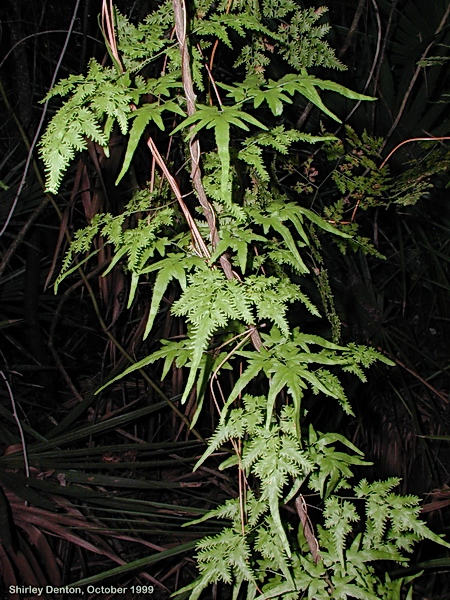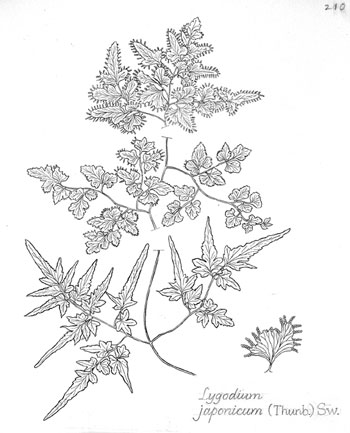|
Hardy Fern Home L. japonicum resources
All Ferns � Lygodiaceae �� Lygodium
�Other Genera
|
| Lygodium japonicum | ||
Japanese climbing fern | ||
|
Etymology
Japonicum refers to Japan.
Description
Rhizome: short-creeping, branching, short, blackish hairs.
Frond: 300 cm high , but can be much more, deciduous, somewhat dimorphic, the fertile pinnae (in upper part of frond) narrowed, blade/stipe ratio: 30:1. Stipe: twining, pale brown, lustrous, 10-30 cm, vascular bundles: 1, a simple cylinder. Blade: 3-pinnate or more, twining rachis, 2-pinnate pinnae, papery, short, curved hairs on both blade surfaces. Pinnae: alternate, a pair of 2-pinnate segments, less than 20 cm long; costae densely hairy above and sparsely so below, distinctly winged; segments lanceolate, lobed; fertile segments fringed; veins free, forking, ending in marginal teeth. Sori: , indusium: false, pear-shaped scale, sporangia: in 2 rows, below the margin, maturity: late summer to early winter. Culture
Habitat: thickets in low mountains.
Distribution: Japan, Korea, China.
Hardy to -15�C, USDA Zone 7.
Distinctive Characteristics
twining habit
Synonyms
Ophioglossum japonicum Thunb. Adiantum scandens Lour. Hydroglossum japonicum (Thunb.) Willd. Lygodium scandens (L.)Sw. |
|
|
Notes
Morphology The Flora of North America disagrees with the above from the Flora of Japan, omitting hairs oon the costa, rachis, and upper surface, and the winged costae.
Morphology The Flora of North America disagrees with the above from the Flora of Japan, omitting hairs oon the costa, rachis, and upper surface, and the winged costae.
|
Lygodium japonicum. Fertile pinnae. Hawaii. �Photo by Forest & Kim Starr (USGS) |

Lygodium japonicum. Sterile and fertile pinnae. �Photo � Shirley Denton, from her web site, with permission. |
|
Lygodium japonicum. Fertile pinna. �Copyright � 2008 by Robbin Moran |
